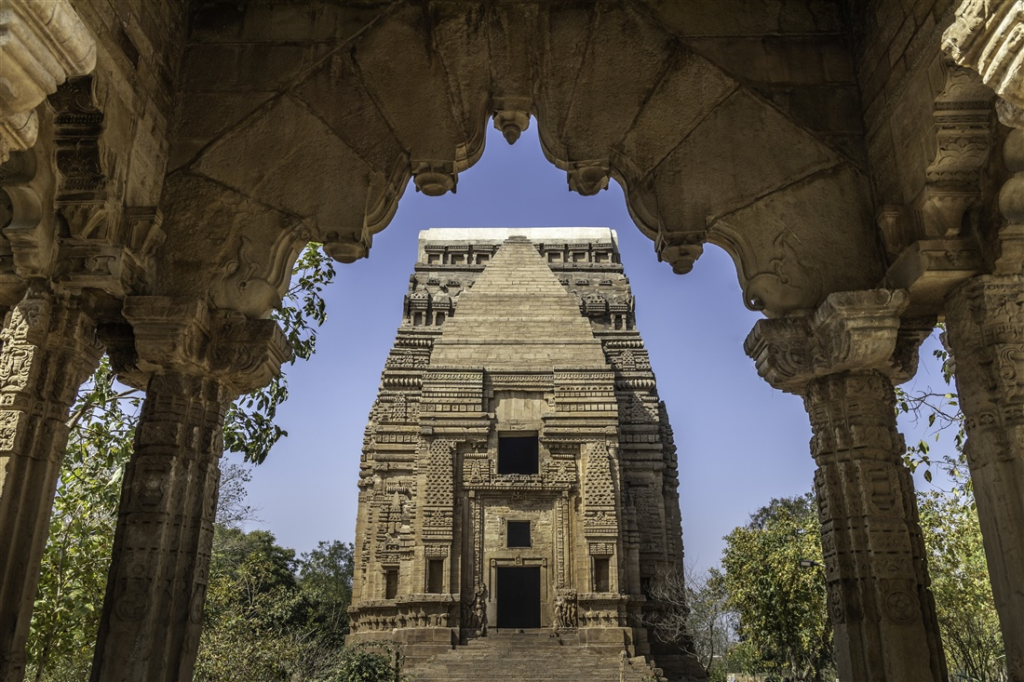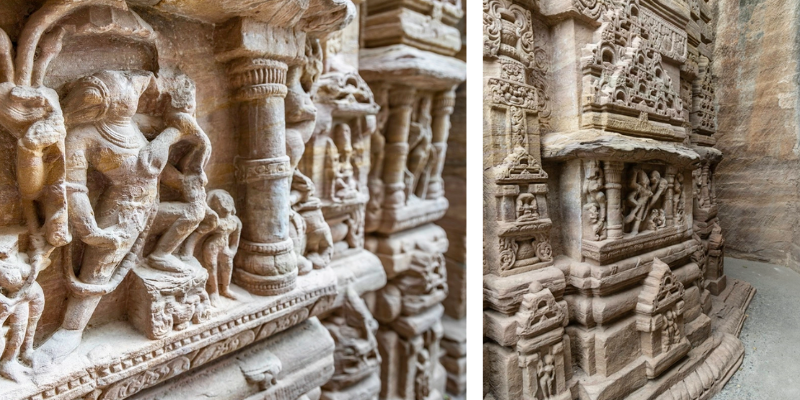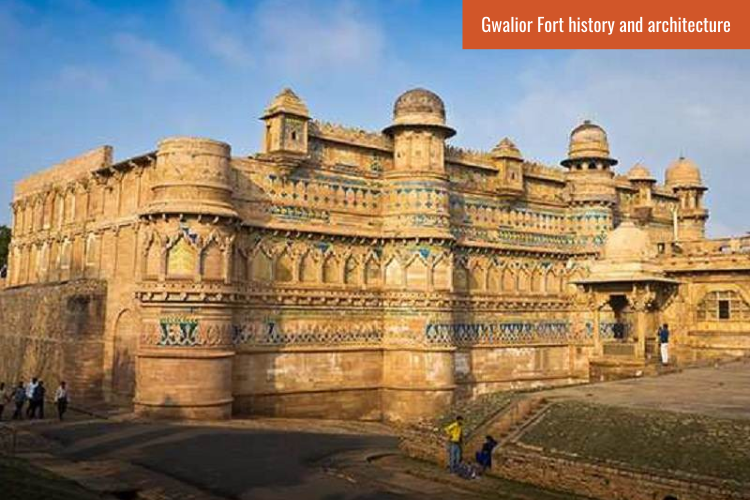Gwalior Fort is one of the famous historical forts in Madhya Pradesh, India. Situated atop a cliffed rocky plateau called Gopachal parvat or Gopagiri, the fort recognizes itself among the best fortresses of India. The fort is also considered among the oldest forts in Madhya Pradesh and northern India. But the marvelous history of Gwalior Fort, is perhaps, the most prominent reason of it’s popularity.
The fort presently houses several structures including Hindu temples, Sikh Gurdwaras, schools and palaces. Remarkably, the age of construction varies from 6th century up to 19th century.
Built with sandstone and lime mortar, the fort is one of the prominent structures in the city. At one point of time, the Gwalior fort was regarded as most invincible fortress of north and central India. Only way to capture the fort was to cut all the line of supplies from outside and enforce a surrender. Probably that’s why the fort had witnessed many act of sieges executed by many rulers in the past.
Gwalior Fort is also famous to house the second oldest record of numeric ‘zero’ in the world inside a small temple of it. A stone inscription, more than 1500 years old, uses the numeric zero symbol having a place value similar to modern decimal notation.
Ancient history of Gwalior Fort
When Gwalior Fort was actual founded, is still not clear today. Earliest references of Gwalior Fort history dates back to 6th century CE. The fort’s oldest structures and inscriptions affirms footprints of several dynasties, spanning a time frame of several centuries. But when actually the fortification at Gopachal hill of Gwalior took place, is massively debatable.

Early rulers of this region included the Mauryas, Sungas, Kushanas, and Nagas until 5th century CE. But no traces of record about the fort’s existence is yet discovered.
Huna footprints at Gwalior Fort
Gwalior inscription of Mihirakula is the oldest historical record of Gwalior. In his inscription, Mihirakula described his construction of a Sun temple. But despite being within the Gwalior fort premise, the 6th century inscription lacks any information about the fort. Many historians, therefore, express doubt whether Gwalior fort really existed atop Gopagiri during 6th century CE or not.

Gwalior inscription of Mihirakula describes the heroics of his father Toramana, as a ruler of the earth. It further describes how well Tormana had ruled his government with truthfulness and justice. Gwalior inscription also describes Mihirakula as ‘the lord of the earth, as of 520 CE.
Medieval history of Gwalior fort
Many dynasties have left their footprints atop the cliff of Gopachal. Gwalior fort has many structures, rock cut monuments built during medieval era. But the oldest historical record of Gwalior fort dates back to 10th century. With the establishment of Mughal empire rule in India, several accounts of Mughal poets and novels became the major resource of Gwalior fort history.
Kachhawaha reign
Gwalior fort early history is based on the famous King Suraj Sen and saint Gwalipa story. Suraj Sen was a local Rajput chieftain of Kachhawaha dynasty. Many historians believe the theory of Kachhawaha king Suraj Sen built the Gwalior fort. However, Kachhawaha rule in the surrounding city of Gwalior during 7th century CE has a lot more certainty. Suraj kund inside Gwalior fort, is believed to be the holy lake, which Gwalipa gave Suraj Sen to recover from leprosy. But again, no clear signs that Gwalior fort existed during King Suraj Sen’s rule.
Gurjara Pratihara rule at Gwalior
Pratihara clans emerged in Gwalior between mid of 8th and early 9th century. Also known as Gurjara-Pratihara clans, they probably were a trusted tributary of the Kachhawaha Rajputs. Gwalior fort houses famous Teli ka Mandir, a temple exhibiting amazing Pratihara art and architecture in Madhya Pradesh. Teli ka Mandir of Gwalior marks a strong presence of Pratihara dynasty in the fort and the region.

Two Chaturbhuja Temple inscriptions dated 875 and 876 CE, descbribes Gwalior as a part of Kingdom of Kannauj. One of the Chaturbhuja Temple inscriptions contains the earliest record of zero. Historians take the record of earliest zero inscription as a massive find in the history of Gwalior fort, Madhya Pradesh, India.

Chaturbhuja temple of Gwalior fort exhibits exquisite arts of 9th century. The classsic sculptures of Hindu gods and goddesses in different forms represent the culturl aspects of medieval Gwalior as well.

Kachchhapaghata Rajput reign
Kachchhapaghata, a Rajput clan of Amber emerged in power during 10th century. The Rajput dynasty had a significant influence in Gwalior. Kachchhapaghata king Mahipala built the Sahastrabahu temple (famous as Sas Bahu temple) near Gwalior fort. Sas bahu Temple is a classic example of famous Kachchhapaghata art and architecture of 10th century.

Gwalior inscriptions dated 1093 CE and 1104 CE record two major grants of king Mahipala. Discovery of several silver and gold coins of King Mahipala in the region is another evidence of strong Kachchhapaghata presence at Gwalior.
But the existence of Gwalior fort during early 11th century has a stong evidence base. In 1022 CE, Mahmud of Ghazni besieged the fort. According to Tabaqat-i-Akbari, he lifted the siege against a tribute of 35 elephants. Tabaqat-i-Akbari by , has unquestionably the oldest mention about Gwalior Fort. Therefore, a group of historians strongly believe that Kachchhapaghata kings built Gwalior Fort around 10th century CE.
Delhi Sultanate possession
Gwalior fort went under Delhi Sultanate possession in 1232, during the reign of Iltutmish. The fort remained under Delhi for next two centuries. The period was more a silent period in the history of Gwalior fort, since no substantial record of development in art, architecture, trades and economy.
Tomar Rajput rule
In 1398, the fort came under Vikram Singh, the first Tomar Rajput king of Gwalior fort. Man Singh Tomar (1486-1516) was the last but most notable Tomar Rajput ruler of Gwalior fort. He renovated the fort extensively. Man Singh Tomar further built Man Mandir, a noteworthy structure inside Gwalior fort. King Man Singh also had to built Gujari Mahal, to fulfil the demand of her queen Mrignayani Devi. Both Man Mandir palace and gujari Mahal are known for exquisite interior decorations and splendid architectures of these period.

Gwalior fort has few more notable constructions, built by Tomar Rajput kings. Karan Mahal and Vikram Mahal are the most prominent ones among them. King Karan Singh (alias Kirti Singh), the 2nd Tomar ruler of Gwalior Fort, had built Karan Mahal. Vikram Mahal were built by King Vikramaditya Singh, elder son of Man Singh.
Lodi expeditions at Gwalior fort
Lodi emperors of Delhi Sultanate made several attempts during early 16th century to capture the strategic Gwalior fort. Sikandar Lodi himself attempted in 1505 but failed to capture the fort. Ibrahim Lodi, his son, attacked the fort in 1516. King Man Singh died in the battle which brought an end of Tomar rule at the fort.
Mughal possession at Gwalior fort
After first battle of Panipat in 1526 CE, Babur began Mughal Era in India, Mughal control established at Gwalior fort. Mughal emperor Akbar finally captured the used the fort as jail for political prisoners. Akbar imprisoned his own cousin, Abul Kasim inside the fort. Later, Kasim was also executed here. Emperor Jahangir, Akbar’s son and successor, also used Gwalior Fort as jail.
Confinement of Sikh Guru Hargobind at the age of 14 years, was perhaps the greatest political injustice during Jahangir’s reign. Guru Hargobind was the sixth out of the Ten Sikh Gurus. After an imprisonment of 3 years, or arguably 10 years, Guru Hargobind was released on the occasion of Diwali. Sikh community still celebrates the day as ‘Bandi Chhor Divas’ festival.
Gwalior Fort had also been a place of imprisonment and execution of many Mughal princes. Mughal emperor Aurangzeb, prisoned and killed Murad Bakhsh, his own brother, to protect his undisputed sovereignty. He also killed his nephew Sulaiman Shikoh at Gwalior Fort.
Acquisition by Jat rulers of Gohad
After death of Aurangzeb in 1707 CE, Mughal control over the fort weakened. Bhim Singh Rana, the Jat ruler of Gohad, seized the fort and defeated Mughals in the Battle of Gwalior. Gwalior fort thereafter remained under the Jats of Gohad for next few decades.
Maratha-British conflict around Gwalior Fort
Mahadji Shinde (Scindia) captured Gwalior Fort in 1755 CE, removing Jats of Gohad. But Maratha sovereignty at Gwalior Fort was rarely toruble free. The fort witnessed several Maratha-British conflicts. In 1780, British Governor Warren Hestings restored the Gohad Kings at the fort. But the Marathas recaptured the fort again in 1784 CE.
During second Anglo Maratha war between 1803 and 1805, the fort went under British control. But the Shindes reestablished their authority again in 1808. The British-Maratha conflict continued until Shinde dynasty accepted British suzerainty in 1844 CE. Gwalior fort beacme the part of Gwalior State. After 1844, with British dominance all over the country, Gwalior Fort lost its strategic importance. However, Scindia dynasty continued ruling the fort as the protectorate of British Government until 1947.
Gwalior fort during modern age history
Modern age in India began since 1850. So, references of modern age history of Gwalior fort mostly came from several government documents, news papers and many other authentic sources.
Rani Lakshmibai: Rebellion of 1857
Gwalior Fort had served as the base for Rani Lakshmi Bai, queen of Jhansi, following the rebellion of 1857. Rani Lakshmi Bai captured Gwalior Fort from the Shindes on 1 June 1858. Unable to resist the attack, the Shindes fled to British garrison at Agra. Commander Huge Rose, in order to mitigate the rebel unrest, reached Gwalior without delay.
Gwalior fort is often recognised as the last battlefield of Rani Lakshmibai. Rebellions led by Lakshmi Bai decided to attack the British troop on 16 June. One the next day, 17 June 1858, Rani Lakshmi Bai was killed, probably by a carbine shot during a cavalry action. The battle took place at Kota-ki-Serai near Phool Bag, 3 kilometers from Gwalior Fort. After Rani Lakshmi Bai died, her body was cremated by local people under a tamarind tree. Hugh Rose described her as ‘personable, clever and beautiful’ in the British account of the battle.
Gwalior Fort post independence of India
The Company forces recaptured Gwalior in next three days. With British support, Shinde rule re-established at Gwalior State and Gwalior fort. AFter India achieved freedom in 1947, Gwalior became the part of the State of Madhya Pradesh. In present day, the Archaeological Survey of India and Madhya Pradesh state archaeology jointly takes care of the fort.
Frequently Asked Questions on Gwalior Fort
Gwalior Fort, located at the center of Gwalior city, finds its place among the best fortresses of India. The fort is known for its stunning architecture and unique history. Gwalior Fort is also famous as the last battlefield of Rani Lakshmi Bai during the Rebellion of 1857.
The fort also houses the record of 2nd oldest numeric zero, discovered in a 6th century stone inscription.
Teli ka Mandir was built in 9th century CE during the reign of Pratihara king Mihira Bhoja. According to a legend, it was built with the money donated by oil merchants. Hence, the temple was named ‘Teli Ka Mandir’ (Temple of Oil’).
Gwalior Fort timing is from 7:00 AM to 5:30 PM, open for all 7 days a week.
There is a nominal entry fee charged for entrance in Gwalior Fort:
For Indians: INR 75 per person
For Foreigners: INR 250 per person
Yes. Photography is allowed inside the fort. No additional fee is charged for photography.

